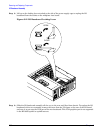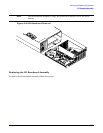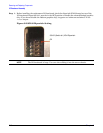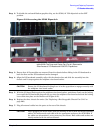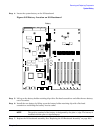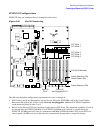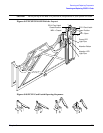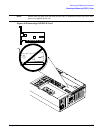
Chapter 6
Removing and Replacing Components
Removing and Replacing PCI/PCI-X Cards
216
Step 8. Replace the top cover. (See “Replacing the Top Cover” on page 183.)
Step 9. Reset the server time and date, and restore the iLO MP configuration settings. Proceed as follows:
a. Using the system console, set the system time and date using the BCH DATE command.
b. Using the system console, configure the iLO MP. Incorporate settings saved before removing the
I/O baseboard assembly or set up the iLO MP as needed. (For additional information about
using the iLO MP, see the HP Integrity and HP 9000 Integrated Lights-Out Management
Processor Operations Guide.)
Removing and Replacing PCI/PCI-X Cards
HP 9000 rp4410 and rp4440 servers can contain up to eight PCI/PCI-X cards. PCI/PCI-X cards are located on
the I/O baseboard assembly, under the top cover. Two of these cards are dedicated to I/O functions and require
that the server be powered off for card replacement. The remaining six PCI/PCI-X cards can be hot-plugged
(replaced while power is on and the system is operating). This section describes hot-pluggable operations and
PCI/PCI-X card replacement and addresses the following topics:
• PCI/PCI-X Configurations
Describes PCI/PCI-X capabilities and relates card functions and capabilities to specific slots.
•Online Addition (OLA)
Installing new PCI/PCI-X expansion cards in empty slots without powering off the server.
• Online Replacement (OLR)
Replacing a PCI/PCI-X card without powering off the server. This action requires suspending the
associated driver. The existing driver for the old card must be compatible with the new card.
CAUTION A special OLR requirement for HP-UX 11i v1 (and higher) is that the card to be replaced
must be exactly the same as the removed card. This is also called like-for-like replacement.
• PCI/PCI-X Slot Location (Locate)
To easily locate the PCI/PCI-X slot at which to perform a hot-pluggable operation, you can command the
attention LEDs on the OLX divider and the I/O baseboard to blink and act as visual cues to the active slot
location. This operation is always initiated through a software or web interface, and is optional to the
operating system on the server.



